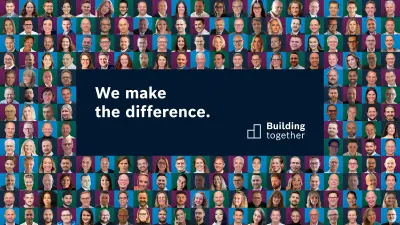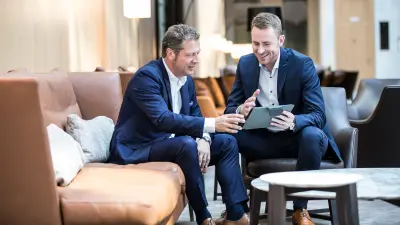“What I love most about acoustic engineering projects is listening to the results of my work”
David Ziegler has applied his extensive experience and love of acoustics to hundreds of customer projects involving public address, and voice alarm systems. He knows that bad sound can ruin even the best concert.

No public address or voice alarm configuration is like another
Life often takes us on an enormous detour before eventually leading us back to where we started. This is also true of careers. When David Ziegler was young, he loved playing with cables, amplifiers, soldering irons, guitars, loudspeakers, and circuit diagrams. And today he once again deals with circuit diagrams and speakers, having essentially turned what used to be his hobby into his profession. As the manager responsible for the life safety portfolio of Bosch Energy and Building Solutions in Grasbrunn, Germany, Ziegler is mainly in demand as an electroacoustics expert. He spends his days combining public address, and voice alarm technologies to forge even better security solutions that, thanks to digitalization, raise both to an unprecedented standard of quality.

Passion for a hobby fueled passion for his profession
“I mostly work on projects in which we develop completely novel public address and voice alarm system ideas,” explains Ziegler. For him, most large projects – such as airports, data centers, and sports arenas – begin like a blank sheet of paper on which he sketches an idea. No building is like another in terms of acoustics, and designing a security solution for it therefore also calls for a unique, unprejudiced approach. “It depends on a building’s physical parameters. The art is in taking these into account. For example, it's important to avoid ‘stimulating’ hard surfaces too much. Sound strikes a wall and is reflected, then hits another wall and also bounces off it. The more times this happens, the more diffuse and difficult to understand the sound gets. A classic example is the Cologne Cathedral, which has a reverberation period of five to six seconds.” Listening to Ziegler makes you curious to learn more. He has a knack for describing things like sound waves, sound pressure, room acoustics, and the speech transmission index (STI) so that they come alive. The STI is a measure of speech intelligibility: for example, how well spectators understand loudspeaker announcements.
He probably owes his special talent to having spent practically his whole life in this field. David’s father was a electromechanics specialist who focused on music-related electronics: building and repairing loudspeakers, power amplifiers, and complex sound reinforcement systems. His brothers have also pursued audio-related careers. Inspired by his father, Ziegler trained as an electrician while mixing music for bands and events on the side. During his military service he was assigned to a telecommunications unit, and then also put himself through college by working as an electrotechnician. Ziegler eventually wound up specializing in fire extinguishing systems for server rooms, data centers and similar facilities. That changed when he joined Bosch in 2005, a career move that enabled him to return to electroacoustics. Ziegler managed a workshop before becoming a system consultant and sales expert specialized in professional public address and electroacoustic systems for emergency alarm and voice alarm systems.

Creative security solutions for customers in different industries
“Bosch is a technology company where anyone with an affinity for technical things instantly feels right at home,” says Ziegler. “We cover a wide range of technologies and fascinating areas of endeavor that are unique in the market. So anyone who loves innovating fits right in.” Ziegler loves swapping ideas with colleagues who work in the same field, and greatly appreciates the company’s international network and how various fields of endeavor are interlinked. “We never use standardized ‘off the rack’ solutions, because every project is unique and our customers’ needs vary enormously. You have to be able to listen closely and then come up with a unique solution in each case. Bosch Energy and Building Solutions lets my team and me take liberties that aren’t typical in our industry. If we get an idea, we’re encouraged to try it out – and if it works, we make progress. This in turn strengthens the whole company, because original ideas are crucial for us to continue being an innovation driver.”
Ziegler works out the details of concepts and supports the planning work for widely ranging projects. Many systems across Germany bear his signature and those of his colleagues. Solutions created by them can be found at airports, in motorway tunnels, at schools, in lobbies, in hotels, in sports arenas and so on. In short, just about everywhere that it’s important not only to deliver good sound but above all to ensure the safety of visitors, who need to be warned in case an emergency situation arises. Hands-on experience counts when planning a project. “While sitting at my desk I visualize how something that’s described and illustrated in blueprints and plans will look and work in actual practice. In many cases, we proceed on the basis of a building plan and a list of possible technical solutions. For designing public address and voice alarm systems, I draw on my knowledge of the individual components or on data sheets, mixing and combining these ingredients to forge a solution that is both appropriate and technically feasible.” While this sounds rather playful, it involves a combination of expertise, teamwork, visits to trade shows, tests, and many conversations with technicians and developers. “I know where the limits of solutions are. It’s vital for us to test and push back these limits in order to stay competitive. We have to tinker and experiment in order to come up with the best possible solutions.” In other words, which components are needed inside a building or where loudspeakers should be mounted. “I stay in close touch with the business unit that’s responsible for actually making the products. We talk a lot about what is technically doable and what else can be developed. It’s great that I’m often involved in the development process, which lets me contribute my knowledge and ideas about what’s important at the practical level.”

The key to success: simulation using a 3D model
Ziegler passes on his detailed specifications, which are then integrated into the building plans. The acoustics are visualized in space with the aid of a 3D simulation containing details such as seating, walls, materials like concrete or glass, how speakers are suspended and angled, and so on. “The CAD model shows us the speakers with arrows indicating how their output radiates. They can be fed with different frequencies to assess the results. To ensure that the sound is the same everywhere, the acoustic pressure also has to be uniform across all points,” he explains. One important criterion for inspecting and assessing public address and voice alarm systems is speech intelligibility, expressed as the STI. “If you build a system but neglect to properly simulate it, you run the risk of falling short of the defined index,” explains the acoustics expert.
Inadequate audio quality can result in hazards: in airport terminals, train stations, sports stadiums, school auditoriums, conference rooms, and many other facilities. Announcements that can be clearly heard and understood everywhere are key for the success of emergency measures such as rescue missions or evacuations. Which is why Ziegler insists that a voice alarm system isn’t ready until it works safely and reliably.
When a project nears completion, Ziegler always looks forward to the moment when he can play music over the system. “You’re probably familiar with this from concerts. If the sound technician at the mixing board doesn’t do a good job, it can ruin an entire performance.” The system is therefore always put through its paces with the volume turned way up, so loud in fact that you can almost see the sound waves. “Electroacoustics is beautiful because you get to hear what you’ve done,” adds Ziegler with a smile.


